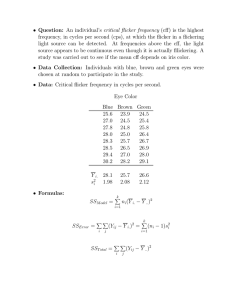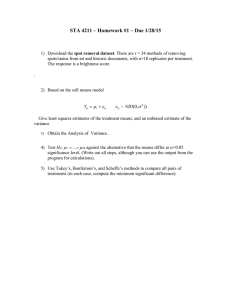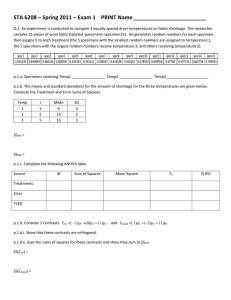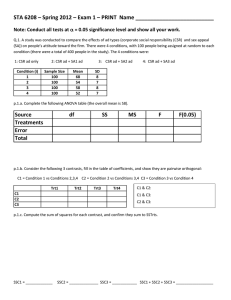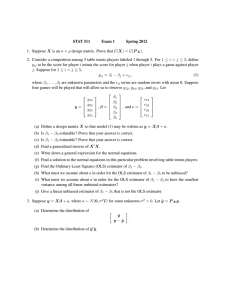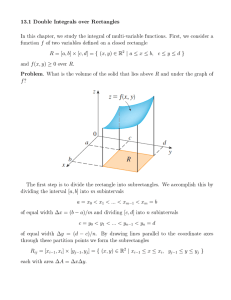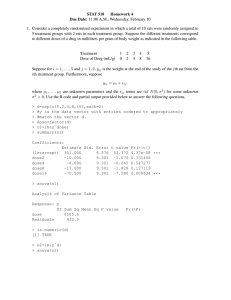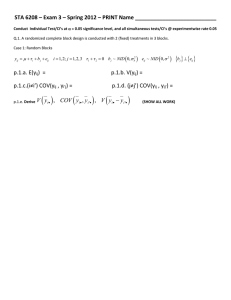STA 6208 – Exam 3 – Spring 2015 – PRINT...
advertisement
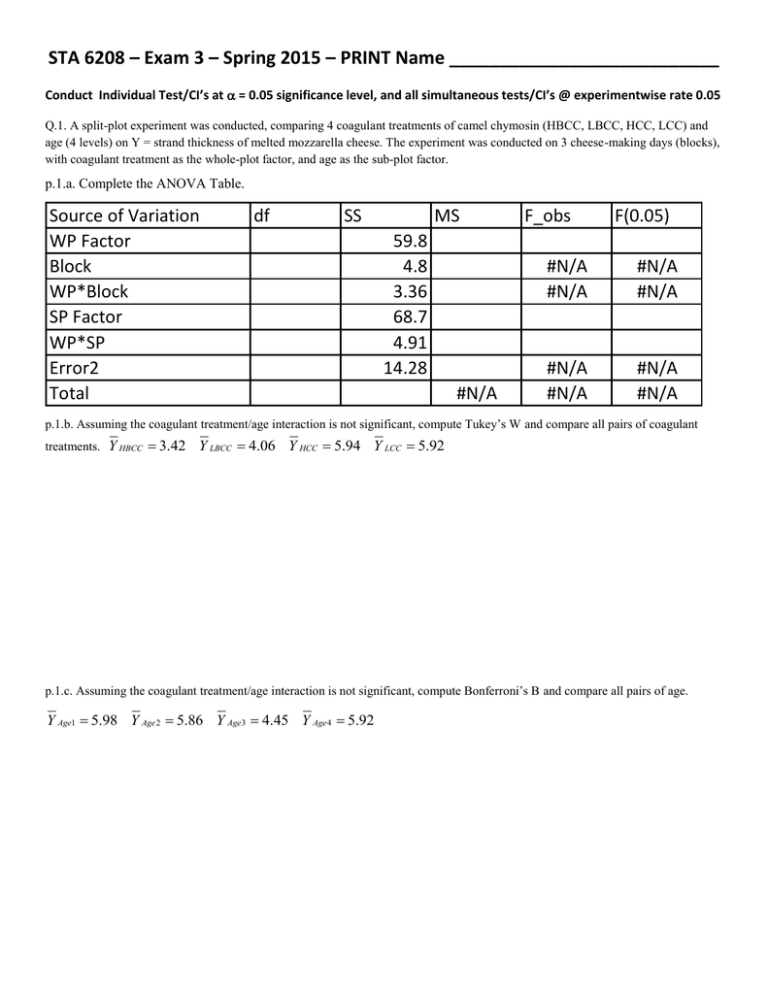
STA 6208 – Exam 3 – Spring 2015 – PRINT Name ___________________________ Conduct Individual Test/CI’s at = 0.05 significance level, and all simultaneous tests/CI’s @ experimentwise rate 0.05 Q.1. A split-plot experiment was conducted, comparing 4 coagulant treatments of camel chymosin (HBCC, LBCC, HCC, LCC) and age (4 levels) on Y = strand thickness of melted mozzarella cheese. The experiment was conducted on 3 cheese-making days (blocks), with coagulant treatment as the whole-plot factor, and age as the sub-plot factor. p.1.a. Complete the ANOVA Table. Source of Variation WP Factor Block WP*Block SP Factor WP*SP Error2 Total df SS MS 59.8 4.8 3.36 68.7 4.91 14.28 #N/A F_obs F(0.05) #N/A #N/A #N/A #N/A #N/A #N/A #N/A #N/A p.1.b. Assuming the coagulant treatment/age interaction is not significant, compute Tukey’s W and compare all pairs of coagulant treatments. Y HBCC 3.42 Y LBCC 4.06 Y HCC 5.94 Y LCC 5.92 p.1.c. Assuming the coagulant treatment/age interaction is not significant, compute Bonferroni’s B and compare all pairs of age. Y Age1 5.98 Y Age 2 5.86 Y Age3 4.45 Y Age 4 5.92 Q.2. A study compared doses of a drug on female rats’ activity levels in a maze. A sample of 91 rats were selected, and randomized such that 21 rats received the Control Dose, 25 received Low Dose, 24 received Medium Dose, and 21 received High Dose. Each rat’s activity levels were observed at 4 time points after dosing (15, 30, 45, and 60 minutes). Hint: There are a total of 21+25+24+21=91 rats in the study. Complete the following ANOVA table. The dose and time means are given in the second table. Source Dose Rat(Dose) Time Dose*Time Error2 Total df SS MS 176677 F F(0.05) Significant? #N/A #N/A #N/A #N/A #N/A #N/A #N/A #N/A #N/A 2161 465319 #N/A Trt n_dose Time1 Time2 Time3 Time4 Mean Control 21 165.9 136.3 121.4 103.4 131.8 LowDose 25 167.8 148.4 123.7 118.4 139.6 MidDose 24 168.3 140.3 117.2 109.8 133.9 HighDose 21 184.4 156.2 136.3 122.7 149.9 Sum/Mean 91 171.3 145.3 124.4 113.7 138.7 Q.3. A bioavailability study for sulpride involved 3 treatments (sulpride alone (A), sulpride with sucralafate (B), and sulpride with antacid (C)). It was conducted in 3 time periods with 6 subjects in a replicated latin square. The ANOVA and the design are given below, for Y = Urinary excretion of sulpride in 24 hours. The means are: Y A 31.0 Y B 18.6 Y C 20.9 Y 23.5 p.3.a. Complete the ANOVA table. Source Trts Periods Subjects Error Total df SS MS 51 380 1083 #N/A F_obs #N/A #N/A #N/A #N/A F(0.05) #N/A #N/A #N/A #N/A Subject\Period 1 2 3 4 5 6 1 A C B C B A 2 B A C A C B 3 C B A B A C p.3.b. How many times does each treatment appear in each subject? p.3.b. How many times does each treatment appear in each Period? p.3.c. Use Tukey’s HSD to compare all pairs of treatment means. HSDij = _______________________________ Connect trts that are not significantly different B C A Q.4. A randomized complete block design is conducted with t (fixed) treatment in r blocks. Case 1: Random Blocks yij i b j eij i 1,..., t ; j 1,..., b t i 1 i 0 b j ~ NID 0, b2 eij ~ NID 0, 2 p.4.a. E(yij) = p.1.b. V(yij) = p.4.c.(i≠i’) COV(yij , yi’j) = p.1.d. (j≠j’) COV(yij , yij’) = p.4.e. Derive V y i , COV y i , y i ' , V y i y i ' (SHOW ALL WORK) b e j ij Case 2: Fixed Blocks yij i j eij i 1,..., t; j 1,..., r t i 0 i 1 p.4.f. E(yij) = j 1 j 0 eij ~ NID 0, 2 p.1.g. V(yij) = p.4.h. (i≠i’) COV(yij , yi’j) = p.4.j. Derive V r y , i p.1.i. (j≠j’) COV(yij , yij’) = COV y i , y i ' , V y i y i ' (SHOW ALL WORK) Q.5.
